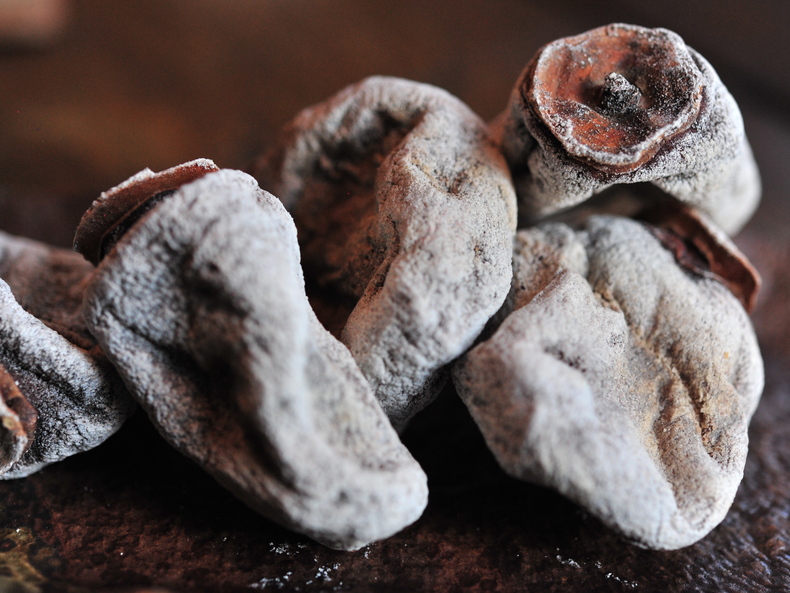2.25.10 Strange Fruit
Despite what they may look like (withered breasts? moldy mushrooms?) these are actually dried persimmons—hachiyas, I think, because of their pointy ends. I picked them up at Mitsuwa, the Japanese market in New Jersey. Having recently snacked on some delicious dried persimmons from the farmer's market in Santa Monica, I was inspired to experiment with these. Right now, they're gently simmering on the stove with some dried tart cherries in a broth of orange juice and honey. (Spiked with a little cardamom, of course.) I'll let you know how they turn out. In the meantime, I'm having my breakfast of creamy sheep's milk yoghurt with some poached prunes and a few of those candied kumquats that first made their appearance alongside the burnt-orange ice cream. I am in heaven. I have loved prunes since childhood and fail to understand why they have been relegated to the geriatric set. The California Prune Counsel even started this big campaign to call them "dried plums." Which is, of course, what they are, but still. What's not to like? Prunes are essentially raisins, only bigger, meatier and more deeply flavorful. But even if you don't care for prunes, this is the season for delicious compotes made from dried fruits. Rather than buying flavorless, out-of-season fruits from Chile or wherever, consider turning to the more local dried bounty: apples, nectarines, apricots, cherries, prunes, raisins, dates, figs, etc. Any combination of these, poached in water to cover, reconstitutes into a soft, luscious tangle of sweet flavors.
Better yet, poach them in fruit juice (orange, lemon and pomegranate are especially nice but you can experiment), toss in some citrus zest or pieces of rind, maybe some cinnamon, a little ginger, a couple of cloves, whatever you like. I usually add a couple of tablespoons of honey or agave, and a nice pinch of sea salt. For an adult version—delicious served with ice cream, creme fraîche or creme anglaise—use a fruity red wine as the poaching liquid. Cooking time depends on the fruit and how soft you want it. Just check it from time to time, and if the liquid cooks down to much, add more. You want a nice syrupy sauce to spoon over the fruit.My persimmons are still on the stove; it's been about half an hour and I had to add another 1/2 cup of water because I want them to soften up a bit more. Their delicious perfume has filled the kitchen where Titi and I are snug as two bugs in a rug. There's been a massive snowfall here, and it's continuing to come down. Huge pine branches have crashed into the yard and there they lie, like sleeping giants under a great white duvet.Here's a recipe for fruit compote I found online. I haven't made this myself but thought you might want something more specific than what I just gave you, above. I'm not sure why it instructs you to cook the fruits separately—maybe because they all take different times to soften. (I don't mind if some are more broken down than others.) I also think you can do without all the sugar, but you be the judge of that.DRIED FRUIT COMPOTEfrom Gourmet, November 20072 1/2 cups water2 1/2 cups dry white wine1/2 cup plus 2 tablespoons sugar1/2 vanilla bean, split lengthwise3 (3- by 1/2-inch) strips of lemon zest1 cup dried Calmyrna figs (5 ounces), trimmed, halved lengthwise if large1/2 cup dried California apricots (3 1/2 ounces)1/4 cup dried sour cherries (3 ounces)Bring water, wine, sugar, vanilla bean (if using), and zest to a boil in a heavy medium saucepan over medium heat, stirring until sugar has dissolved. Stir figs into syrup and simmer, uncovered, until tender, about 5 minutes. Transfer figs with a slotted spoon to a bowl. Stir apricots into syrup and simmer until tender, about 3 minutes. Transfer apricots with slotted spoon to bowl with figs. Stir cherries into syrup and simmer until just tender, about 1 minute, then add to fruit using slotted spoon.Boil syrup until reduced to about 1 cup, about 12 minutes. Discard lemon zest and vanilla bean (if using; if using extract, stir in now), then pour syrup over fruit and cool to room temperature. Serve compote with tart.







1 Comment